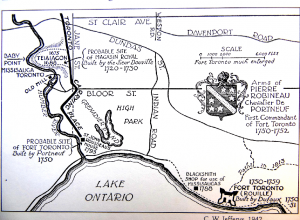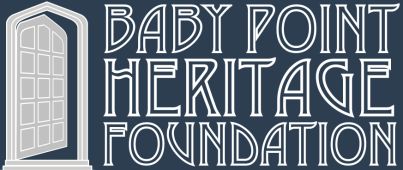 (International Trade at Baby Point: Illustration of trade between the French and First Nations by Charles. W. Jefferys, 1942, pulblic domain)
(International Trade at Baby Point: Illustration of trade between the French and First Nations by Charles. W. Jefferys, 1942, pulblic domain)
French Voyageurs and the Fur Trade: In September 1615, explorer Étienne Brûlé, travelling with a group of Huron/Wendat allies, followed the Carrying Place Trail/Pathway** south from Lake Simcoe to Lake Ontario, making Brûlé likely the first white man to reach Lake Ontario. Brûlé was on a mission for Samuel de Champlain to find more First Nations allies in their quest to control the lucrative fur trade and meet Europe’s enormous demand for (mostly) beaver pelts. Felt hats made of beaver pelts had become highly fashionable in Europe.
When a group of English merchants aiming to gain control of the fur trade sent a flotilla to New France (including modern day Ontario) Brûlé deserted Champlain to join the English who soundly defeated Champlain in 1629. After Champlain’s death in 1633, Brûlé returned to the Huron, who now considered him a traitor. The Huron burned him at the stake, dismembered him and ate his heart. The Iroquois, who were allies of the English also vying to control the fur trade, began destroying Huron and Algonquin settlements on the north shore of Lake Ontario. At this time Teiaiagon was ransacked and the Huron, who fled for the south shores of Lake Ontario, abandoning the village and leaving it for the Iroquois.
In 1687, a French-led army attacked their long-time adversaries, the Iroquois, burning Teiaiagon to the ground and killing its inhabitants. The series of conflicts over the fur trade is now known as the Beaver Wars (or Iroquois Wars or French and Iroquois Wars). The land comprising modern-day Baby Point was ceded to the Mississauga, who occupied a village on the west bank of the Humber River.
 (Probable location of Le Magasin Royal, Illustration by Charles W. Jefferys, 1942, public domain)
(Probable location of Le Magasin Royal, Illustration by Charles W. Jefferys, 1942, public domain)
Le Magasin Royal: The Douville brothers started trading at the Humber River mouth in 1716. Under the orders of Governor Denonville, Douville built the fort known as Le Magasin Royal in 1720 at the site of modern-day Baby Point. Le Magasin Royal and Fort Rouillé (where exhibition park now stands) were the first two European establishments in what is now Toronto. The probable location of Le Magasin Royal is where the tennis courts and Baby Point Club stand today. In exchange for fur pelts, Douville’s list of traded goods includes buttons, shirts, ribbons, combs, knives, looking glasses, axes, flour, lard, salt, pepper, prunes, raisins, olive oil, tobacco, vermillion, powder and shot. Le Magasin Royal was abandoned in 1730 as new establishments were built to the south of the site.
**The Carrying Place Trail/Pathway was a long portage along the eastern shore of the Humber River. The route terminated when reaching navigable water at some unknown spot on the Holland River near Holland Marsh. It was a route to Lake Simcoe and the fur-rich lands to the north and west. This route was used not only by First Nations, but also by the coureurs de bois. It was integral to the trade for beaver pelts in Canada, feeding the seemingly insatiable European market for fur.
